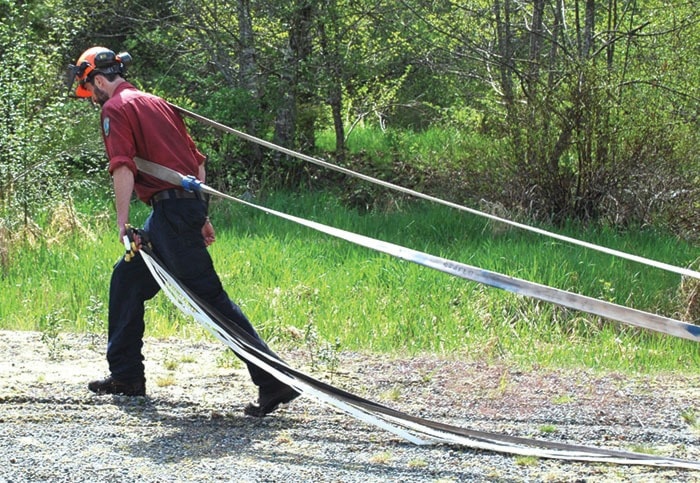Residents in the York Road area found out first-hand what it’s like to be evacuated from their home Sunday morning.
While the community was never under any real threat, some residents volunteered to be forced from their homes and shuttled to a reception centre at Oyster Bay Resorts as part of a wildfire training exercise.
The mock disaster started with a car accident on Highway 19A that caused a fire to ignite. In the pretend scenario, drought-like conditions on a hot, windy day caused the fire to spread up into the York/Deerfield Road area, posing a threat to the community.
The exercise, which took place Sunday morning, was a chance for several agencies to work together and polish up their skills in the event of a real disaster.
Clinton Parker, a forest protection officer involved in the mock scenario, said this is the first time in the more than 20 years he’s been with the Wildfire Management Branch that he’s seen an exercise on such a large, multi-agency scale.
“Two years ago we did a smaller scale version of this, but in this area, on this scale, it’s been a long time,” Parker said. “Since Friday the Oyster River Fire Department has organized a fire training and rescue simulation weekend. The premise was over the first couple of days to provide fire departments with wildfire training. All of the groups participating today went through training, some classroom, some hands on and the intent of today (Sunday) was to take the knowledge learned over the last couple of days and put it into practice.”
The agencies involved in the simulation included 15 different fire departments from the Lower Mainland and Vancouver Island, the RCMP, Comox Valley and Campbell River Search and Rescue, BC Hydro, BC Ambulance, and the Wildfire Management Branch under the provincial Ministry of Natural Resource Operations.
Staff Sgt. Troy Beauregard of the Campbell River RCMP said it’s “good for everybody in the community to see all these groups working together.”
The training involved the use of fire engines, water tenders and rescue vehicles. Firefighters also used a Type 1 Structural Protection Unit (a giant sprinkler) with the help of BC Hydro to protect the sub station off of York Road from igniting into flames, and further spreading the wildfire.
BC Ambulance crews also got in on the action, with local residents volunteering as victims.
Glen Greenhill, unit chief for the Campbell River BC Ambulance station, and Campbell River paramedics Blair Menegozzo, Dave Hutton and Trevor Melville were able to help large groups of people using the medical supplies unit.
The unit, which looks similar to a standard ambulance, is one of 15 in the province and three on the Island and it is stationed in Campbell River. The unit carries more supplies than the average ambulance which allows paramedics to treat several victims at one time. Greenhill said the medical services unit was used to help the injured involved in the mine bus accident on Highway 28 in 2011.
The unit allows paramedics to treat victims at the scene with specialized supplies for those with injuries classified as serious, intermediate and minor. The medical supplies unit also allows paramedics to set up a command post on the scene of an incident because it’s equipped with a radio, desk, access to electricity, plus a generator to allow paramedics to create their own electricity.
“It’s a great unit to send for a large event,” Greenhill said. “It gives us the additional equipment and supplies required.”
For the ‘victims’ in Sunday’s wildfire scenario who were not injured, but forced from their homes, they were provided with emergency supplies at the reception centre set up at Oyster River Resorts.
It was an opportunity for volunteers with both the Strathcona and Comox Valley Emergency Programs to receive evacuees and provide them with warm blankets, shelter, and food.
“We’re going through and knocking on doors and evacuating and those people are being told, like in a real-life situation, to go to the reception area at Oyster Bay Resorts and they’re receiving people down there,” said Parker, with the wildfire management branch. “It’s working like it should.”
Parker added that overall the exercise was a test so that “in an event there is a real emergency, we’ve worked out all the glitches.”
Other agencies involved in the training exercise included: the First Nations Emergency Services Society of BC, Campbell River and Comox Valley Amateur Radio, Campbell River Emergency Support Services, and local forest companies.
